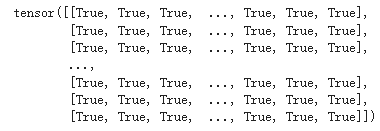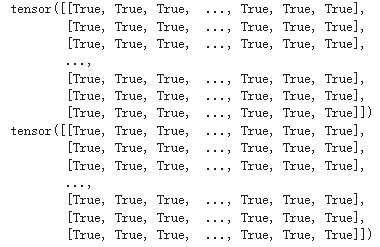关于torch.nn.LSTM()的输入和输出
主角torch.nn.LSTM()
初始化时要传入的参数
| Args:
| input_size: The number of expected features in the input `x`
| hidden_size: The number of features in the hidden state `h`
| num_layers: Number of recurrent layers. E.g., setting ``num_layers=2``
| would mean stacking two LSTMs together to form a `stacked LSTM`,
| with the second LSTM taking in outputs of the first LSTM and
| computing the final results. Default: 1
| bias: If ``False``, then the layer does not use bias weights `b_ih` and `b_hh`.
| Default: ``True``
| batch_first: If ``True``, then the input and output tensors are provided
| as `(batch, seq, feature)` instead of `(seq, batch, feature)`.
| Note that this does not apply to hidden or cell states. See the
| Inputs/Outputs sections below for details. Default: ``False``
| dropout: If non-zero, introduces a `Dropout` layer on the outputs of each
| LSTM layer except the last layer, with dropout probability equal to
| :attr:`dropout`. Default: 0
| bidirectional: If ``True``, becomes a bidirectional LSTM. Default: ``False``
| proj_size: If ``> 0``, will use LSTM with projections of corresponding size. Default: 0
input_size:一般是词嵌入的大小
hidden_size:隐含层的维度
num_layers:默认是1,单层LSTM
bias:是否使用bias
batch_first:默认为False,如果设置为True,则表示第一个维度表示的是batch_size
dropout:直接看英文吧
bidirectional:默认为False,表示单向LSTM,当设置为True,表示为双向LSTM,一般和num_layers配合使用(需要注意的是当该项设置为True时,将num_layers设置为1,表示由1个双向LSTM构成)
模型输入输出-单向LSTM
import torch
import torch.nn as nn
import numpy as np
inputs_numpy = np.random.random((64,32,300))
inputs = torch.from_numpy(inputs_numpy).to(torch.float32)
inputs.shape
torch.Size([64, 32, 300]):表示[batchsize, max_length, embedding_size]
hidden_size = 128
lstm = nn.LSTM(300, 128, batch_first=True, num_layers=1)
output, (hn, cn) = lstm(inputs)
print(output.shape)
print(hn.shape)
print(cn.shape)
torch.Size([64, 32, 128])
torch.Size([1, 64, 128])
torch.Size([1, 64, 128])
说明:
output:保存了每个时间步的输出,如果想要获取最后一个时间步的输出,则可以这么获取:output_last = output[:,-1,:]
h_n:包含的是句子的最后一个单词的隐藏状态,与句子的长度seq_length无关
c_n:包含的是句子的最后一个单词的细胞状态,与句子的长度seq_length无关
另外:最后一个时间步的输出等于最后一个隐含层的输出
output_last = output[:,-1,:]
hn_last = hn[-1]
print(output_last.eq(hn_last))

模型输入输出-双向LSTM
首先我们要明确:
output :(seq_len, batch, num_directions * hidden_size)
h_n:(num_layers * num_directions, batch, hidden_size)
c_n :(num_layers * num_directions, batch, hidden_size)
其中num_layers表示层数,这里是1,num_directions表示方向数,由于是双向的,这里是2,也是,我们就有下面的结果:
import torch
import torch.nn as nn
import numpy as np
inputs_numpy = np.random.random((64,32,300))
inputs = torch.from_numpy(inputs_numpy).to(torch.float32)
inputs.shape
hidden_size = 128
lstm = nn.LSTM(300, 128, batch_first=True, num_layers=1, bidirectional=True)
output, (hn, cn) = lstm(inputs)
print(output.shape)
print(hn.shape)
print(cn.shape)
torch.Size([64, 32, 256])
torch.Size([2, 64, 128])
torch.Size([2, 64, 128])
这里面的hn包含两个元素,一个是正向的隐含层输出,一个是方向的隐含层输出。
#获取反向的最后一个output
output_last_backward = output[:,0,-hidden_size:]
#获反向最后一层的hn
hn_last_backward = hn[-1]
#反向最后的output等于最后一层的hn
print(output_last_backward.eq(hn_last_backward))
#获取正向的最后一个output
output_last_forward = output[:,-1,:hidden_size]
#获取正向最后一层的hn
hn_last_forward = hn[-2]
# 反向最后的output等于最后一层的hn
print(output_last_forward.eq(hn_last_forward))

https://www.cnblogs.com/LiuXinyu12378/p/12322993.html
https://blog.csdn.net/m0_45478865/article/details/104455978
https://blog.csdn.net/foneone/article/details/104002372
关于torch.nn.LSTM()的输入和输出的更多相关文章
- torch.nn.LSTM()函数维度详解
123456789101112lstm=nn.LSTM(input_size, hidden_size, num_la ...
- PyTorch官方中文文档:torch.nn
torch.nn Parameters class torch.nn.Parameter() 艾伯特(http://www.aibbt.com/)国内第一家人工智能门户,微信公众号:aibbtcom ...
- pytorch nn.LSTM()参数详解
输入数据格式:input(seq_len, batch, input_size)h0(num_layers * num_directions, batch, hidden_size)c0(num_la ...
- pytorch中文文档-torch.nn.init常用函数-待添加
参考:https://pytorch.org/docs/stable/nn.html torch.nn.init.constant_(tensor, val) 使用参数val的值填满输入tensor ...
- pytorch中文文档-torch.nn常用函数-待添加-明天继续
https://pytorch.org/docs/stable/nn.html 1)卷积层 class torch.nn.Conv2d(in_channels, out_channels, kerne ...
- torch.nn.functional中softmax的作用及其参数说明
参考:https://pytorch-cn.readthedocs.io/zh/latest/package_references/functional/#_1 class torch.nn.Soft ...
- torch.nn.Embedding理解
Pytorch官网的解释是:一个保存了固定字典和大小的简单查找表.这个模块常用来保存词嵌入和用下标检索它们.模块的输入是一个下标的列表,输出是对应的词嵌入. torch.nn.Embedding(nu ...
- pytorch torch.nn.functional实现插值和上采样
interpolate torch.nn.functional.interpolate(input, size=None, scale_factor=None, mode='nearest', ali ...
- pytorch torch.nn 实现上采样——nn.Upsample
Vision layers 1)Upsample CLASS torch.nn.Upsample(size=None, scale_factor=None, mode='nearest', align ...
随机推荐
- Tensor基本理论
Tensor基本理论 深度学习框架使用Tensor来表示数据,在神经网络中传递的数据均为Tensor. Tensor可以将其理解为多维数组,其可以具有任意多的维度,不同Tensor可以有不同的数据类型 ...
- 3D MinkowskiEngine稀疏模式重建
3D MinkowskiEngine稀疏模式重建 本文看一个简单的演示示例,该示例训练一个3D卷积神经网络,该网络用一个热点向量one-hot vector重构3D稀疏模式.这类似于Octree生成网 ...
- 多级中间表示概述MLIR
多级中间表示概述MLIR MLIR项目是一种构建可重用和可扩展的编译器基础结构的新颖方法.MLIR旨在解决软件碎片,改善异构硬件的编译,显着降低构建特定于域的编译器的成本以及帮助将现有编译器连接在一起 ...
- 转置卷积Transposed Convolution
转置卷积Transposed Convolution 我们为卷积神经网络引入的层,包括卷积层和池层,通常会减小输入的宽度和高度,或者保持不变.然而,语义分割和生成对抗网络等应用程序需要预测每个像素的值 ...
- Spring Cloud09: Config 配置中心
一.概述 什么是配置中心呢,在基于微服务的分布式系统中,每个业务模块都可以拆分成独立自主的服务,由多个请求来协助完成某个需求,那么在某一具体的业务场景中,某一个请求需要调用多个服务来完成,那么就存在一 ...
- .NET平台系列26:在 Windows 上安装 .NET Core/.NET5/.NET6
系列目录 [已更新最新开发文章,点击查看详细] 本文介绍如何在 Windows 上安装 .NET. .NET 由运行时和 SDK 组成. 运行时用于运行 .NET 应用,应用可能包含也可能不包 ...
- WordPress安装篇(3):用宝塔面板在Linux上安装WordPress
前面的文章已经介绍了如何在Windows环境安装WordPress,这篇文章来介绍在Linux环境怎样快速安装WordPress.大家都知道,Linux系统相对于Windows系统而言占用资源更少.更 ...
- 02:database 配置(可能出现严格模式配置问题)
DATABASES = { 'default': { 'ENGINE': 'django.db.backends.mysql', 'NAME': 'day42', 'USER': 'root', 'P ...
- centos7安装JDK、CentOS
1.安装JDK 1.1查看系统是否已有自带的JDK rpm -qa |grep java rpm -qa |grep jdk rpm -qa |grep gcj 1.2卸载已有安装 如果没有输出信息, ...
- Go语言中的有缓冲channel和无缓冲channel区别
Go语言中的有缓冲channel和无缓冲channel区别 结论 ch1:=make(chan int)// 无缓冲 ch2:=make(chan int,1)// 有缓冲 无缓冲: 当向ch1中存值 ...
